PowerMill 2019- Autodesk’s Powermill is a leading system for programming CNC machine tools and, with its new release, it’s clear that the company’s investment in the product continues
Since Autodesk’s 2014 acquisition of Delcam, the new owner’s plans for the venerable British developer’s solutions for the manufacturing industry have come under close scrutiny. At the top of the pile sits PowerMill, one of the most advanced systems on the market today for programming CNC machine tools – and since being acquired, the updates have been pretty thick on the ground.
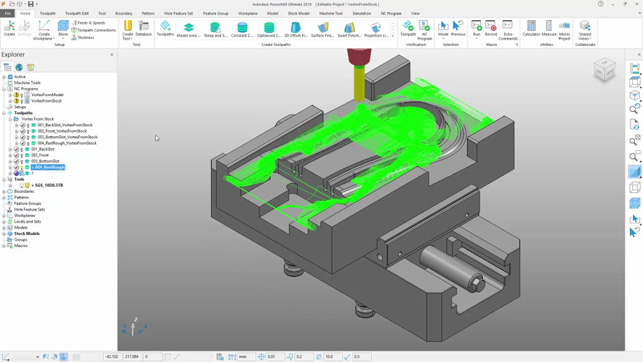
PowerMill now features the Adaptive Clearing tech from HSM, found under the high-speed roughing operation, alongside existing Vortex strategies
The PowerMill 2018 release cycle, for example, saw four updates, bringing new tools as well as the usual fixes to a system that is clearly going through a process of modernisation and expansion. So with that in mind, let’s explore what’s coming up in PowerMill 2019.
Work on the user interface has continued. While 2018 saw the introduction of the ribbon, 2019 continues the usability trend with additional help and tool tips for each command. In terms of learning, there’s a new web-based help system, which can be localised for those without web access and those who have security concerns.
Another key general update for this release is the addition of tools to organise operations more clearly. Using a ‘set-ups’ approach, you can now organise your project into individual folders and maintain associative links between them, whether you’re using the system to manage jobs across multiple machines, multiple set-ups for 5-axis positional work, or replicating the same parts across a bed using work offsets. That will prove useful for many, but just as importantly, it lays the foundation for greater support for tombstones and the like in future releases.
PowerMill 2019 – adaptive clearing
In terms of new machining operations for this release, the big news is that PowerMill is finally getting the ‘Adaptive Clearing’ capability seen in Autodesk’s HSM products – the same technology in Fusion 360.
This is to support the kind of highefficiency, high removal rate, full-carbide cutter depth type operation that’s become more widely available across a range of CAM systems. PowerMill users will also recognise that PowerMill also had Vortex technology introduced a few years ago, which focused on much the same issue.
The difference between Vortex and Adaptive Clearing is that while Vortex focuses on calculating toolpathing from the model geometry outward into the stock, Adaptive Clearing begins its calculation work from the outer boundary of the stock model and works, resulting in most cases in a more efficient toolpath.
Interestingly, rather than adding in a brand-new strategy, it has been added into the existing high-speed roughing dialog as an option. (To use it, select ‘From stock’ rather than ‘From model’.)
PowerMill 2019 – 5-axis tool tilting
Alongside its focus on mould and die, Powermill has also focused on control of 5-axis machine tools, particularly in combination with complex parts, be they mould tools or end-use components from exotic alloys.
As a result, it already has a mature set of tools for ensuring those inherently complex toolpaths are just as robust, but there’s always room for a little enhancement. The core area for the 2019 release is to expand on the existing tools for controlling tool tilting during operations.
PowerMill has offered 5-axis collision avoidance for many years. Programmers had to select from a number of tool tilting options in order to control how the machine would tilt to avoid collisions. The choice made depended on the shape of the model being machined and the toolpath strategy being used. Deciding which option to use was not always straightforward and involved a certain amount of experimentation.
PowerMill 2019 includes an automatic option that helps eliminate the guesswork.
The option can be used for all models and practically all toolpath types – in effect, it’s a ‘one-stop shop’ for collision avoidance.
The key benefit here is that it is much simpler and faster to create safe 5-axis code – a job that can be quite daunting for users new to 5-axis programming.
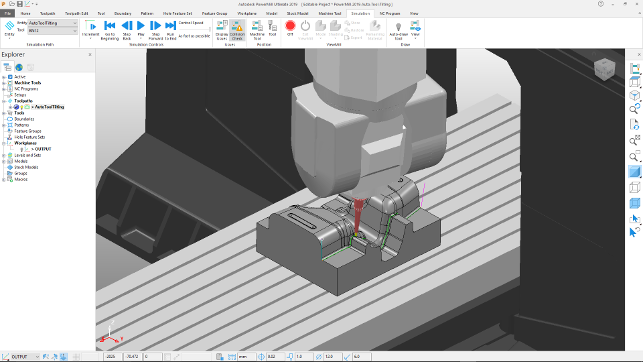
PowerMill now handles tool tilting with less manual input for those truly mindboggling geometries and tool reach
PowerMill 2019 – ViewMill thickness
ViewMill has been PowerMill’s simulation environment for many years and is already pretty rich in terms of capability, other than visualisation of your operations against stock models.
It has been reworked for this release to make it faster to calculate as well as visually higher quality – but perhaps more interesting is the thickness evaluation tool. This allows you to conduct an analysis of your stock model at any point and colour code it to find areas where you’re too far out of tolerance, where there’s an excess or where you might have gouged the part.
These can all be set to specific tolerance values and should prove useful – particularly as you’re able to very quickly get a read on maximum remaining stock, as well as find areas where material remains.
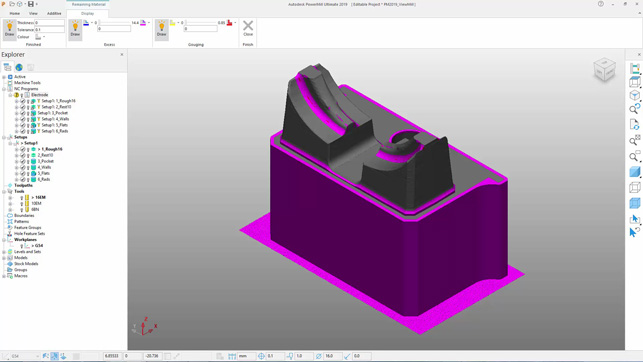
ViewMill now comes with new options to help visualise remaining stock with thickness values available
Production machining
PowerMill’s stock in trade has always been the more complex end of the machining spectrum – the mould and die jobs, controlling 5-axis machines and much more. That said, in recent years, there has been a move to add in more basic forms of machining, so that users don’t need another system to carry out routine tasks.
This work continues with the 2019 release. You’re now able to select feature-like geometry more easily, in particular ‘sides’ or more of what are commonly known as ‘open pockets’, where you don’t want to machine all the way around the exterior of a feature.
You don’t need to chain select edge, but rather select a face and you’re done.
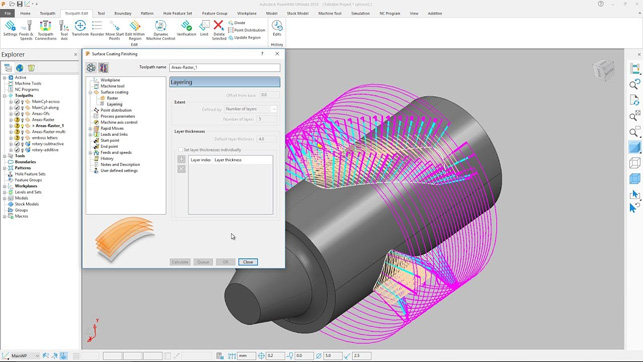
PowerMill 2019 sees the introduction of additive manufacturing support, particularly for driving Directed Energy Deposition (DED) processes
Autodesk drive
If you read our Inventor review last month, you’ll be aware that Autodesk is pushing on in its mission to move customers to subscription-based payment plans. To try and sweeten the deal, the company is introducing tools across most of its product range that are only available to those users who are on subscription.
The first of these to be integrated into PowerMill (and FeatureCAM) is Autodesk Drive. Previously known as A360, this gives you a cloud storage platform, so that your team can share data. It’s like Dropbox, but with a lot more collaboration and CAD viewing tools built in. Drive will even let you inspect toolpaths without relying on an additional ‘viewer’ application, but doesn’t as yet support simulation in the cloud-based viewer.
The second bonus is that you’ll also be able to link PowerMIll (and FeatureCAM) to Autodesk’s forthcoming Fusion production system. This is a cloud-based environment for managing shopfloor workflows, such as job management and assignment, productivity monitoring and elements of smart factory/machine monitoring.
PowerMill for additive manufacturing
While the updates we’ve looked at address capabilities already inside PowerMill, in the final section, we’re going to investigate additive manufacturing. Those with only a cursory knowledge of how the additive market is evolving might consider this and scratch their chins. After all, PowerMill has always been about machining, and more specifically, about removing material. Additive is the opposite of that, right?
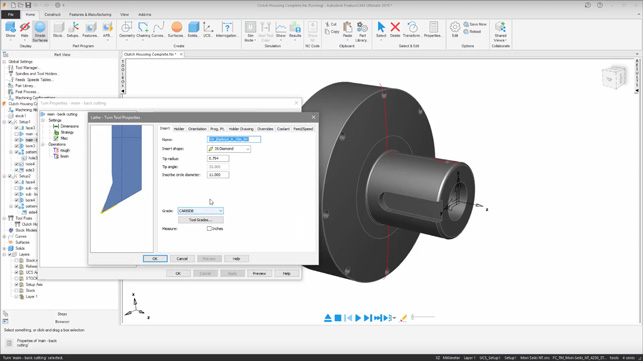
FeatureCAM now support’s multidirectional tooling, such as Sandvik’s PrimeTurning tools
FeatureCam 2019: Intelligent production machining
Let’s talk a little about FeatureCAM. Again, this is a longstanding application in the Autodesk arsenal and is a feature-based CAM system, as opposed to an operation-based CAM system. However, it differs in that it’s built to quickly recognise features, apply machining strategies to them, customise and optimise toolpaths and quickly generate NC Code – whether you’re working with multi-axis milling, turn/mill, Swiss machining and more.
FeatureCAM has always had feature recognition, which has traditionally worked in two ways: automatic or interactive.
The Automatic Feature Recognition (AFR) allows you to find features such as holes, pockets and so on quickly.
Interactive, meanwhile, allows you to dive in and recognise features manually depending on the feature type. The 2019 release introduces a new midway, allowing you to define what feature types you want to search for in or on your part and define them all at once, as opposed to doing so individually. This enables you to recognise groups of holes, pockets, bosses, sides and so forth at the same time.
There have also been efforts to streamline the user experience of the software, such as the expanded standard thread definition library, as well as workflows reworked to make them a little easier. This includes defining set-ups using a planar selection and improved Z axis selection, something that will be familiar to Fusion 360 and HSM users.
Another update is how FeatureCAM defines centre drilling operations. Whereas previously, centre drills were allocated a constant included angle and tip angle, you can now modify the top-included angle to suit make sure it is consistent with your actual tool, which gives you a more accurate simulation and adjusts the NC code so that it actually reflects the geometry of your operation.
The last two updates we’ll cover are focused on turning and Swiss programming.
In terms of turning, there’s now support for more specialised inserts (such as Sandvik’s CoroPrime PrimeTurning) for bi-directional turning with the same 35-degree insert, but with a less aggressive stock engagement and greater material removal rate. In order to apply this turning technique, you can simply use the ‘Back Cutting’ tick box located in the turn feature properties.
There’s also improved support for radial patterns, allowing the user to rotate in C in each instance on a turn/mill component, cutting using the XY coordinates, as opposed to C coordinates. This gives a far better surface finish.
New to Swiss programming, FeatureCAM now has a Swiss-suitable configuration file located in your C: drive, so the defaults for Swiss machining are now much more suitable for Swiss documents. These are usually smaller in size and have much finer tolerances.
FeatureCAM will also now programme features that aren’t aligned with the C axis, using a fixed angle tool holder; this allows parts to be machined at this fixed angle without the need for coordinate transformation, which some machines cannot produce.
You’ll be able to generate a thread path from a curve, which is useful for defining a thread without the use of a cross section, utilising instead the length of the curve.
That’s providing of course that there are no arcs in the curve itself and that the postprocessor and machine tool is capable of cutting computed thread cycles.
Finally, it’s worth noting that FeatureCAM, just like PowerMill, has a direct connection to the Autodesk Drive available to subscribers. This utilises the Autodesk Desktop Connector so that Windows users can save directly to Drive from Windows Explorer. It also provides integration for those looking to explore shop-floor management with Fusion Production.
| Product | PowerMill & FeatureCAM 2019 |
|---|---|
| Company name | Autodesk |
| Price | on application |






